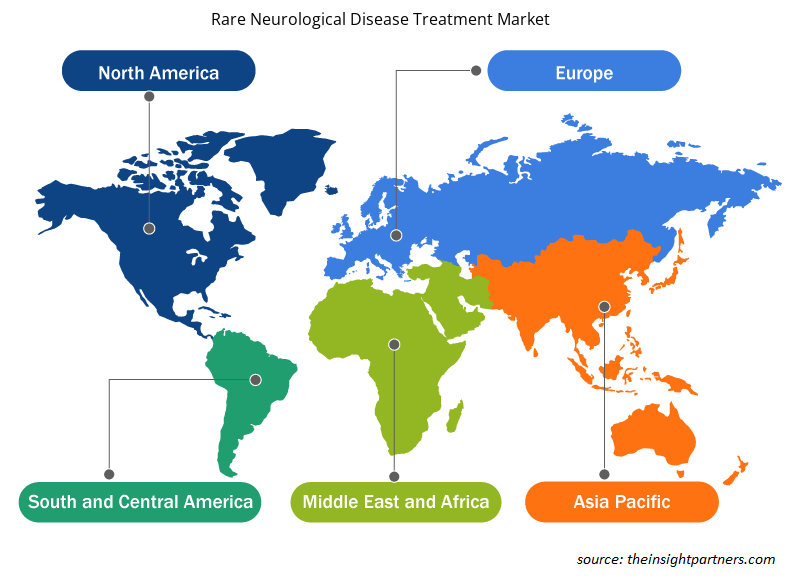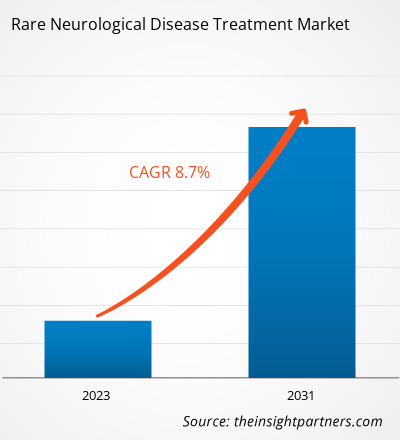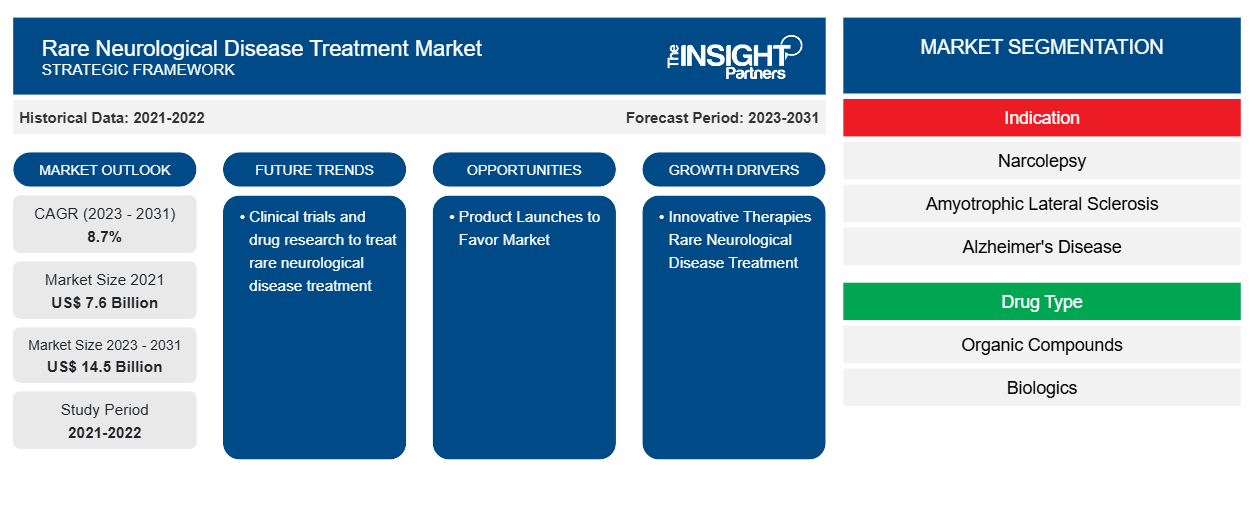Der Markt für die Behandlung seltener neurologischer Erkrankungen wurde 2021 auf 7,6 Milliarden US-Dollar geschätzt und soll bis 2031 14,5 Milliarden US-Dollar erreichen. Der Markt soll von 2023 bis 2031 eine durchschnittliche jährliche Wachstumsrate von 8,7 % verzeichnen. Klinische Studien und Arzneimittelforschung zur Behandlung seltener neurologischer Erkrankungen werden voraussichtlich weiterhin wichtige Trends auf dem Markt für die Behandlung seltener neurologischer Erkrankungen bleiben.
Marktanalyse zur Behandlung seltener neurologischer Erkrankungen
Innovative Therapien Behandlung seltener neurologischer Erkrankungen
Das Centre for Drug Evaluation and Research (CDER) gab 2023 die Zulassung für die erste Enzymersatztherapie zur Behandlung nicht-neurologischer Auswirkungen von Alpha-Mannosidose (einer seltenen genetischen lysosomalen Speicherkrankheit) bekannt. Darüber hinaus ergab eine klinische Studie im März 2024, dass eine experimentelle Gentherapie Patienten mit seltenen neurodegenerativen Erkrankungen helfen könnte. Darüber hinaus wurde im Mai 2022 das Accelerating Rare Disease Cures (ARC)-Programm ins Leben gerufen, um wissenschaftliche und regulatorische Innovationen und Engagement voranzutreiben und die Verfügbarkeit von Behandlungen für Patienten mit seltenen Erkrankungen zu beschleunigen. Die FDA wird die Infrastruktur, das Fachwissen und die strategische Führung des ARC-Programms nutzen, um eine interzentrische Task Force für seltene neurodegenerative Erkrankungen einzurichten. Die oben genannten Faktoren sind für das einflussreiche Wachstum des Marktes für die Behandlung seltener neurologischer Erkrankungen in den Jahren 2021–2031 verantwortlich.
Marktübersicht zur Behandlung seltener neurologischer Erkrankungen
Technologie, Innovation und intelligente technologische Lösungen wie diese beeinflussen den Markt für die Behandlung seltener neurologischer Erkrankungen weiterhin erheblich. Innovative Therapien zur Behandlung seltener neurologischer Erkrankungen und Produkteinführungen sind die einflussreichsten Faktoren für das Wachstum des Marktes für die Behandlung seltener neurologischer Erkrankungen. Klinische Studien und Arzneimittelforschung zur Behandlung seltener neurologischer Erkrankungen sind ein wichtiger Trend für das Wachstum des Marktes für die Behandlung seltener neurologischer Erkrankungen. Steigende Forschungs- und Entwicklungsaktivitäten (F&E) werden lukrative Marktchancen bieten.
Passen Sie diesen Bericht Ihren Anforderungen an
Sie erhalten kostenlose Anpassungen an jedem Bericht, einschließlich Teilen dieses Berichts oder einer Analyse auf Länderebene, eines Excel-Datenpakets sowie tolle Angebote und Rabatte für Start-ups und Universitäten.
-
Holen Sie sich die wichtigsten Markttrends aus diesem Bericht.Dieses KOSTENLOSE Beispiel umfasst eine Datenanalyse von Markttrends bis hin zu Schätzungen und Prognosen.
Markttreiber und Chancen für die Behandlung seltener neurologischer Erkrankungen
Produkteinführungen begünstigen den Markt
Im November 2022 kündigte CENTOGENE die Einführung des „Biodata Network“ an, einem Portfolio datenbasierter seltener und neurodegenerativer Erkrankungen für Biopharmaunternehmen und Forschungsinstitute. Darüber hinaus stellen die CENTOGENE-Datensätze eine geschätzte 20-prozentige Steigerung der Breite und Tiefe der derzeit über BC-Plattformen verfügbaren Genomdaten dar . Dieser Datensatz spiegelt eine vielfältige geografische und ethnische Stichprobenbasis wider, einschließlich der Prävalenz pädiatrischer Fälle seltener und neurodegenerativer Erkrankungen, einschließlich klinischer, multiomischer und soziodemografischer Daten. Daher werden solche innovativen Datensätze zur Produkteinführung für die Behandlung seltener neurologischer Erkrankungen in den kommenden Jahren einen erheblichen Beitrag leisten.
Steigende Forschungs- und Entwicklungsaktivitäten (F&E) – eine Chance
- Im Dezember 2023 kündigte die Food and Drug Administration (FDA) Zuschüsse und Verträge mit öffentlichen und privaten Einrichtungen an, die die Kosten für Forschung und Entwicklung (F&E) zur Prävention, Diagnose, Linderung, Behandlung und Heilung der Amyotrophen Lateralsklerose (ALS) und anderer seltener neurodegenerativer Erkrankungen bei Erwachsenen und Kindern decken.
- Im Juni 2023 gaben Ipsen und Medentia eine Zusammenarbeit im Bereich der umfassenden Arzneimittelforschung und Medizinalchemie bekannt. Durch diese Zusammenarbeit werden die Unternehmen gemeinsam neue Lösungen für Menschen auf der ganzen Welt entwickeln, wobei der Schwerpunkt auf seltenen Krankheiten, darunter seltenen neurodegenerativen Erkrankungen, liegt.
Daher werden steigende F&E-Aktivitäten lukrative Marktchancen bieten und dem Markt für die Behandlung seltener neurologischer Erkrankungen in den kommenden Jahren einen beträchtlichen Marktanteil sichern.
Behandlung seltener neurologischer Erkrankungen
Marktbericht-Segmentierungsanalyse
Wichtige Segmente, die zur Ableitung der Marktanalyse zur Behandlung seltener neurologischer Erkrankungen beigetragen haben, sind Eignung und Dienstleistungen.
- Basierend auf der Indikation ist der Markt für die Behandlung seltener neurologischer Erkrankungen in Narkolepsie, amyotrophe Lateralsklerose, Alzheimer-Krankheit, Multiple Sklerose, spinale Muskelatrophie, Duchenne-Muskeldystrophie und andere unterteilt. Die Alzheimer-Krankheit könnte im Jahr 2023 einen größeren Marktanteil haben.
- Basierend auf dem Arzneimitteltyp ist der Markt für die Behandlung seltener neurologischer Erkrankungen in organische Verbindungen und Biologika unterteilt. Die Biologika könnten im Jahr 2023 einen größeren Marktanteil haben.
- Basierend auf der Verabreichungsart ist der Markt für die Behandlung seltener neurologischer Erkrankungen in orale und injizierbare Mittel unterteilt. Das orale Segment könnte im Jahr 2023 einen größeren Marktanteil haben.
- Basierend auf dem Vertriebskanal ist der Markt für die Behandlung seltener neurologischer Erkrankungen in Krankenhausapotheken, Einzelhandelsapotheken und Sonstige unterteilt. Das Segment Krankenhausapotheken könnte im Jahr 2023 einen größeren Marktanteil halten.
Marktanteilsanalyse zur Behandlung seltener neurologischer Erkrankungen nach geografischer Lage
Der geografische Umfang des Marktberichts zur Behandlung seltener neurologischer Erkrankungen ist hauptsächlich in fünf Regionen unterteilt: Nordamerika, Asien-Pazifik, Europa, Naher Osten und Afrika sowie Südamerika/Süd- und Mittelamerika.
Nordamerika dominiert den Markt für die Behandlung seltener neurologischer Erkrankungen. In Nordamerika haben die USA einen beträchtlichen Anteil an der Behandlung seltener neurologischer Erkrankungen. Die Präsenz führender Hersteller in den USA und zunehmende F&E-Aktivitäten sind die einflussreichsten Faktoren für das Marktwachstum. Der asiatisch-pazifische Raum wird in den kommenden Jahren voraussichtlich die höchste durchschnittliche jährliche Wachstumsrate aufweisen.
Behandlung seltener neurologischer Erkrankungen
Regionale Einblicke in den Markt für die Behandlung seltener neurologischer Erkrankungen
Die regionalen Trends und Faktoren, die den Markt für die Behandlung seltener neurologischer Erkrankungen im Prognosezeitraum beeinflussen, wurden von den Analysten von Insight Partners ausführlich erläutert. In diesem Abschnitt werden auch Marktsegmente und Geografien für die Behandlung seltener neurologischer Erkrankungen in Nordamerika, Europa, im asiatisch-pazifischen Raum, im Nahen Osten und Afrika sowie in Süd- und Mittelamerika erörtert.

- Erhalten Sie regionale Daten zum Markt für die Behandlung seltener neurologischer Erkrankungen
Umfang des Marktberichts zur Behandlung seltener neurologischer Erkrankungen
| Berichtsattribut | Details |
|---|---|
| Marktgröße im Jahr 2021 | 7,6 Milliarden US-Dollar |
| Marktgröße bis 2031 | 14,5 Milliarden US-Dollar |
| Globale CAGR (2023 - 2031) | 8,7 % |
| Historische Daten | 2021-2022 |
| Prognosezeitraum | 2023–2031 |
| Abgedeckte Segmente |
Nach Indikation
|
| Abgedeckte Regionen und Länder |
Nordamerika
|
| Marktführer und wichtige Unternehmensprofile |
|
Dichte der Marktteilnehmer für die Behandlung seltener neurologischer Erkrankungen: Auswirkungen auf die Geschäftsdynamik verstehen
Der Markt für die Behandlung seltener neurologischer Erkrankungen wächst rasant. Dies wird durch die steigende Nachfrage der Endnutzer aufgrund von Faktoren wie sich entwickelnden Verbraucherpräferenzen, technologischen Fortschritten und einem größeren Bewusstsein für die Vorteile des Produkts vorangetrieben. Mit der steigenden Nachfrage erweitern Unternehmen ihr Angebot, entwickeln Innovationen, um die Bedürfnisse der Verbraucher zu erfüllen, und nutzen neue Trends, was das Marktwachstum weiter ankurbelt.
Die Marktteilnehmerdichte bezieht sich auf die Verteilung der Firmen oder Unternehmen, die in einem bestimmten Markt oder einer bestimmten Branche tätig sind. Sie gibt an, wie viele Wettbewerber (Marktteilnehmer) in einem bestimmten Marktraum im Verhältnis zu seiner Größe oder seinem gesamten Marktwert präsent sind.
Die wichtigsten Unternehmen auf dem Markt für die Behandlung seltener neurologischer Erkrankungen sind:
- Allergan (AbbVie) Inc.,
- Bayer AG,
- GlaxoSmithKline plc,
- Johnson & Johnson Services, Inc.,
- Merck & Co., Inc.,
- Novartis,
Haftungsausschluss : Die oben aufgeführten Unternehmen sind nicht in einer bestimmten Reihenfolge aufgeführt.

- Überblick über die wichtigsten Akteure auf dem Markt für die Behandlung seltener neurologischer Erkrankungen
Behandlung seltener neurologischer ErkrankungenMarktnachrichten und aktuelle Entwicklungen
Der Markt für die Behandlung seltener neurologischer Erkrankungen wird durch die Erhebung qualitativer und quantitativer Daten nach Primär- und Sekundärforschung bewertet, die wichtige Unternehmensveröffentlichungen, Verbandsdaten und Datenbanken umfasst. Im Folgenden finden Sie eine Liste der Entwicklungen auf dem Markt für die Behandlung seltener neurologischer Erkrankungen und Strategien:
- Im September 2022 gaben die US-amerikanische Food and Drug Administration (USFDA) und das National Institute of Health (NIH) den Start des „Critical Path for Rare Neurodegenerative Diseases (CP-RND)“ bekannt, einer öffentlich-privaten Partnerschaft mit dem Ziel, das Verständnis neurodegenerativer Erkrankungen zu verbessern und so die Entwicklung von Behandlungen für die amyotrophe Lateralsklerose (ALS) und andere seltene neurodegenerative Erkrankungen zu fördern.
Marktbericht zur Behandlung seltener neurologischer Erkrankungen – Abdeckung und Ergebnisse
Der Bericht „Marktgröße und Prognose zur Behandlung seltener neurologischer Erkrankungen (2021–2031)“ bietet eine detaillierte Analyse des Marktes, die die folgenden Bereiche abdeckt:
- Marktgröße und Prognose auf globaler, regionaler und Länderebene für alle wichtigen Marktsegmente, die im Rahmen des Projekts abgedeckt sind
- Marktdynamik wie Treiber, Beschränkungen und wichtige Chancen
- Wichtige Zukunftstrends
- Detaillierte PEST/Porters Five Forces- und SWOT-Analyse
- Globale und regionale Marktanalyse mit wichtigen Markttrends, wichtigen Akteuren, Vorschriften und aktuellen Marktentwicklungen
- Branchenlandschaft und Wettbewerbsanalyse, einschließlich Marktkonzentration, Heatmap-Analyse, prominenten Akteuren und aktuellen Entwicklungen
- Detaillierte Firmenprofile
- Historische Analyse (2 Jahre), Basisjahr, Prognose (7 Jahre) mit CAGR
- PEST- und SWOT-Analyse
- Marktgröße Wert/Volumen – Global, Regional, Land
- Branchen- und Wettbewerbslandschaft
- Excel-Datensatz
Aktuelle Berichte
Erfahrungsberichte
Grund zum Kauf
- Fundierte Entscheidungsfindung
- Marktdynamik verstehen
- Wettbewerbsanalyse
- Kundeneinblicke
- Marktprognosen
- Risikominimierung
- Strategische Planung
- Investitionsbegründung
- Identifizierung neuer Märkte
- Verbesserung von Marketingstrategien
- Steigerung der Betriebseffizienz
- Anpassung an regulatorische Trends























 Kostenlose Probe anfordern für - Markt für die Behandlung seltener neurologischer Erkrankungen
Kostenlose Probe anfordern für - Markt für die Behandlung seltener neurologischer Erkrankungen